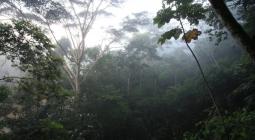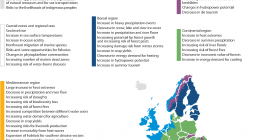The projected timing of abrupt ecological disruption from climate change

Abstract
As anthropogenic climate change continues the risks to biodiversity will increase over time, with future projections indicating that a potentially catastrophic loss of global biodiversity is on the horizon1,2,3. However, our understanding of when and how abruptly this climate-driven disruption of biodiversity will occur is limited because biodiversity forecasts typically focus on individual snapshots of the future. Here we use annual projections (from 1850 to 2100) of temperature and precipitation across the ranges of more than 30,000 marine and terrestrial species to estimate the timing of their exposure to potentially dangerous climate conditions. We project that future disruption of ecological assemblages as a result of climate change will be abrupt, because within any given ecological assemblage the exposure of most species to climate conditions beyond their realized niche limits occurs almost simultaneously. Under a high-emissions scenario (representative concentration pathway (RCP) 8.5), such abrupt exposure events begin before 2030 in tropical oceans and spread to tropical forests and higher latitudes by 2050. If global warming is kept below 2 °C, less than 2% of assemblages globally are projected to undergo abrupt exposure events of more than 20% of their constituent species; however, the risk accelerates with the magnitude of warming, threatening 15% of assemblages at 4 °C, with similar levels of risk in protected and unprotected areas. These results highlight the impending risk of sudden and severe biodiversity losses from climate change and provide a framework for predicting both when and where these events may occur.
Data availability
All datasets used here are publicly available. Expert verified range maps are available from https://www.iucnredlist.org/resources/spatial-data-download and http://datazone.birdlife.org/species/requestdis. Climate change projections for RCP 8.5, RCP 4.5 and RCP 2.6 for CMIP5 are available from https://esgf-node.llnl.gov/search/cmip5/. Maps of projected risk to biodiversity from climate change are available to view at https://climatehorizons.users.earthengine.app/view/biodiversity-risk.
Code availability
Computer code used in the analysis is available on request from the corresponding author. Code and data that were used to make Figs. 2–4 is available at Figshare (https://doi.org/10.6084/m9.figshare.11814633).
* Find the original article here
8 April 2020
nature





